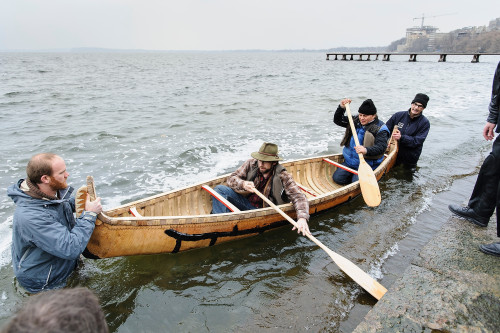Ten years ago, a birchbark canoe cut through the icy waters of Lake Mendota, paddled by its maker, Wayne Valliere (Mino-giizhig in Ojibwe) of the Lac du Flambeau Band of Lake Superior Chippewa. Once back on land, the canoe was installed in Dejope Residence Hall on the University of Wisconsin–Madison campus, where it has hung on display from the dining hall rafters ever since.
Dejope (or Teejop) is the name that the Ho-Chunk and other Indigenous peoples have called Madison for time immemorial. Every day, the canoe gives students a visual connection to the rich and enduring heritage of this land that now makes up UW–Madison’s campus. But after a decade on land, the canoe needed to return to the water.
On Oct. 5, the birchbark canoe once again entered Lake Mendota, marking the 10-year anniversary of its making. Before the canoe launched, Valliere spoke to a gathering that included other members of the canoe building team, community members and students from the first-year interest group “Earth Partnership, Indigenous Arts and Sciences: Restoration Education and Stewardship.”
In his opening remarks, Valliere emphasized the canoe’s cultural significance and its connection to Ojibwe language, culture and education.
“The Ojibwe language is the most complex language in the world,” Valliere said, “So we teach our language as we’re doing our culture things, so there’s more immersion.”
The canoe’s 10-year anniversary, he said, stands as a testament to the preservation of Ojibwe culture.
“We build birchbark canoes in our school, we build dugouts in our school, but most of all, our children hear the sound of our language every day through this practice,” he said.
Wayne Valliere made the canoe during his 2013 tenure as artist-in-residence. He designed it to foster relationships, friendships and mutual reliance between the Lac du Flambeau public school and UW–Madison. Valliere collaborated with students from both UW–Madison and Lac du Flambeau, along with community members.

